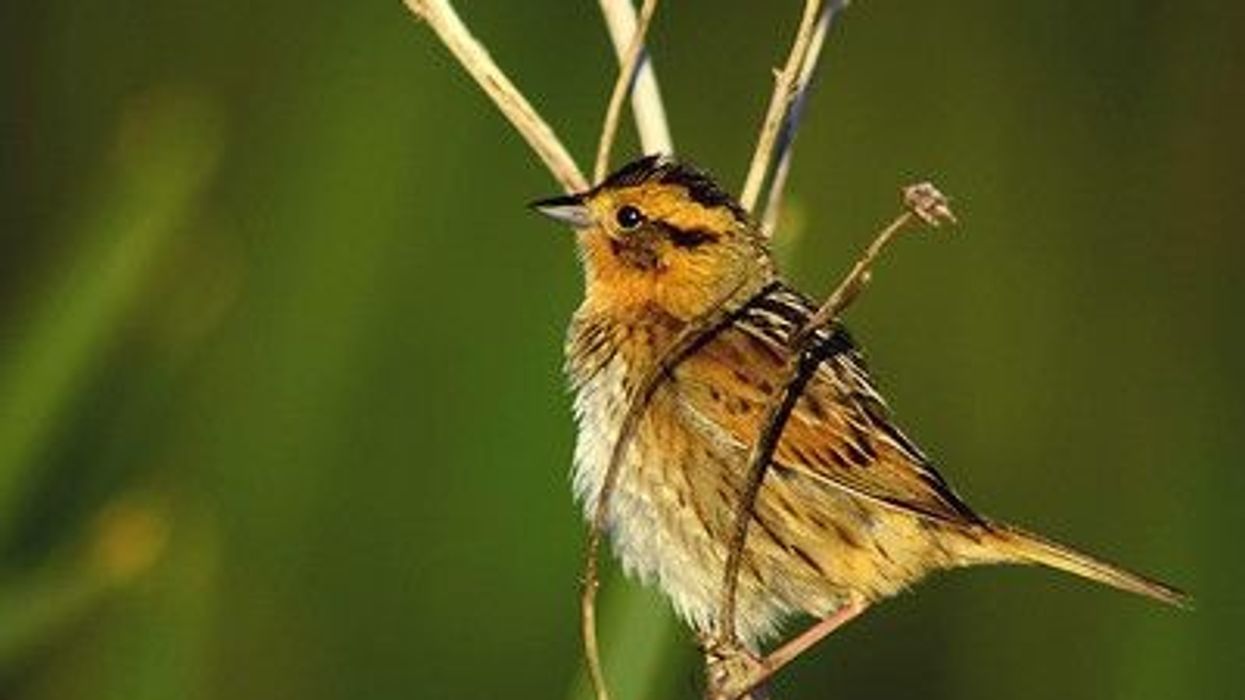The Eurasian tree sparrow (Passer montanus), also known as the European sparrow or the German sparrow, is in the sparrow family. Whilst they can fly in flocks with other species of sparrow, they can be best spotted by their chestnut-colored feathers.
Interestingly, these birds did not spread to North America on their own. In 1870, 12 of these birds were brought from Germany and released in Missouri. Since then they have reproduced and their population has spread to other areas in North America around Missouri, including southeastern Iowa and Illinois.
Thankfully, these amazing birds are not an endangered population. If you want to try your luck at spotting them, you can learn more with this article. You can even learn to prepare a nest for them so you can watch them from the comfort of your own garden and encourage their breeding.
If you enjoy these European sparrow facts, why not become a sparrow expert and also read about the chipping sparrow and the fox sparrow?
Eurasian Tree Sparrow Interesting Facts
What type of animal is a Eurasian tree sparrow?
A Eurasian tree sparrow belongs to the sparrow family.
What class of animal does a Eurasian tree sparrow belong to?
A Eurasian tree sparrow is a bird that belongs to the Aves class.
How many Eurasian tree sparrows are there in the world?
No one is exactly sure about the worldwide population of Eurasian tree sparrows. Experts say the population could be between 190-310 million.
Where does a Eurasian tree sparrow live?
A Eurasian tree sparrow (Passer montanus) lives in a nest. They build their nest off the ground and the nest is made from grass and straw. These nests are often placed in cavities, especially during the winter season.
What is a Eurasian tree sparrow's habitat?
This bird species can be found in North America, in Illinois, southeastern Iowa, and Missouri. They have a wide range and can also be found in other countries around Europe and Asia.
The natural habitat of these birds is in the woods, trees, and bushes. However, the habitat of this bird can also be in nooks and crannies of buildings in rural areas and even in urban areas, especially in buildings close to parks, woods, and forests.
Who do Eurasian tree sparrows live with?
These birds mostly live with their family, consisting of their mate and young chicks. This bird can also be found living in loose colonies, with other similar species of sparrow such as the house sparrow.
How long does a Eurasian tree sparrow live?
The average life span of these birds is three years.
How do they reproduce?
These adult birds reproduce sexually by internal fertilization, meaning that their eggs are fertilized inside the female. Males and females must mate for this to happen, so they find their pair by courting.
Males court a Eurasian tree sparrow female bird during the spring season through calls, singing, and fluffing their feathers.
A Eurasian tree sparrow will form its first breeding pair at around one year old, and they remain loyal to their mate throughout their lives. Eurasian tree sparrow eggs are white or pale gray with spots and speckles.
What is their conservation status?
The conservation status of this species of bird is Least Concern, meaning that there is an abundant population of this species.
Eurasian Tree Sparrow Fun Facts
What do Eurasian tree sparrows look like?
Eurasian tree sparrows have a rich chestnut nape and crown, with black patches on their head and neck. The body of these birds is mostly brown, streaked with black. You can recognize them by their distinct white bars running down their brown wings.
How cute are they?
They are an absolutely adorable species of bird with their beautiful rich chestnut feathers and small size.
How do they communicate?
Just like other sparrows, this species communicates and makes calls via song. The Eurasian tree sparrow song sounds like a series of chirps or chirrup sounds. Most of the time, a male Eurasian tree sparrow call is a song to announce that they are owners of a nest in order to entice a potential female mate.
How big is a Eurasian tree sparrow?
Eurasian tree sparrows are pretty small. In fact, they are 10% smaller than other species of sparrows. They are just 12.5–14 cm (5–5.5 in) long.
How fast can a Eurasian tree sparrow fly?
There is very little research on how fast a Eurasian tree sparrow (Passer montanus) can fly, however, other species of sparrows, specifically the house sparrow, flies at an average speed of 29 mph (46 kmph).
The fastest bird in the world, a peregrine flies at about 124 mph (200 kmph), so you can see that sparrows are not very fast fliers compared to other birds.
How much does a Eurasian tree sparrow weigh?
Eurasian tree sparrows weigh 24 g (0.85 oz), they are a very light and small species.
What are their male and female names of the species?
Males and females are both called Eurasian tree sparrows.
What would you call a baby Eurasian tree sparrow?
A Eurasian tree sparrow baby is called a chick, just like other young baby birds.
What do they eat?
The Eurasian tree sparrow diet consists of grains, fruit, seeds, nuts, flowers, and small invertebrates like insects. They mostly get their food during the summer and fall and they look for food by foraging on the ground.
They look in bushes, plants, and on the ground surrounding trees to find food. To get the food they pick with their beaks and they sometimes fly to chase insects.
In the spring, they eat a lot of insects, especially to feed their newly-hatched young. They can forage solitarily, in small groups and in large flocks too.
Are they aggressive?
This bird is not aggressive to humans, in fact, they are said to be very friendly around humans. However, they will definitely do their best to protect their territory, their nest, and their family from other birds and predators, including their relative the house sparrow.
Would they make a good pet?
These birds would not make good pets are they are better suited to being in the wild. It is much better to build a nest box to help preserve their population and aid their breeding.
Did you know...
The Eurasian tree sparrow and the house sparrow are in a different family to the other species of sparrow in North America. They are in the Passeridae family, whereas other sparrow birds are in the Passerellidae family. You can even notice these two subspecies of sparrows look different to other sparrows.
You used to be able to find these birds more often in urban areas, but now they have been displaced by a similar, but slightly more aggressive species, house sparrows. This Eurasian tree sparrow vs house sparrow battle has been won by house sparrows for now!
These North American birds are all descendants of the 12 Eurasian tree sparrows released in 1870.
Outside North America, Eurasian tree sparrow birds range in size and plumage. In fact, outside North American, there are 33 subspecies of this bird. The subspecies that was released in 1870 in Missouri is from the most widespread subspecies, the Montanus.
The oldest recorded Eurasian tree sparrow bird was four years old.
How to tell the Eurasian tree sparrow from the English sparrow?
A house sparrow is also known as an English sparrow. The English sparrow, or house sparrow, is a little bigger and has gray plumage.
How to make a nesting box for a Eurasian tree sparrow?
It is best to have a weatherproof nesting box with a small entrance hole. There is no need to put any lining in here, although it is said that straw sticking out of the entrance can attract the bird to nest.
It is best placed so that the hole is facing away from the wind and the rain. It should be at least 6-7 ft (1.8-2.1 m) off the ground.
Here at Kidadl, we have carefully created lots of interesting family-friendly animal facts for everyone to discover! Learn more about some other birds including the Hawaiian crow, or swallow.
You can even occupy yourself at home by drawing one on our Eurasian tree sparrow coloring pages.









